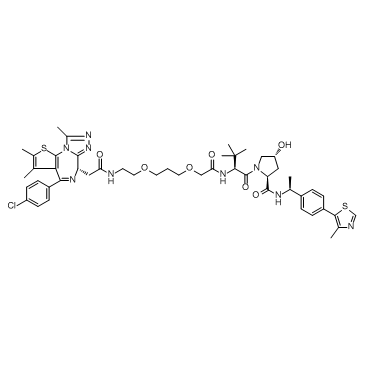ARV-771 |
| Catalog No.GC32685 |
ARV-771 is a potent BET PROTAC based on E3 ligase von Hippel-Lindau with Kds of 34 nM, 4.7 nM, 8.3 nM, 7.6 nM, 9.6 nM, and 7.6 nM for BRD2(1), BRD2(2), BRD3(1), BRD3(2), BRD4(1), and BRD4(2), respectively.
Products are for research use only. Not for human use. We do not sell to patients.

Cas No.: 1949837-12-0
Sample solution is provided at 25 µL, 10mM.
ARV-771 is a potent bromodomain and extra-terminal (BET) proteins degrader based on PROTAC technology with Kd values of 4.7, 7.6, 7.6 nM against BRD2, BRD3 and BRD4, respectively.
ARV-771, a small-molecule pan-BET degrader based on proteolysis-targeting chimera (PROTAC) technology, demonstrates dramatically improved efficacy in cellular models of CRPC as compared with BET inhibition. ARV-771 potently degrades BRD2/3/4 in 22Rv1 cells with a DC50 less than 5 nM. c-MYC protein is a downstream effector of BET proteins. Treatment with ARV-771 results in depletion of c-MYC with an IC50 of less than 1 nM. ARV-771 shows strong antiproliferative effect on 22Rv1, VCaP, and LnCaP95 cell lines. ARV-771 treatment has a pronounced effect on cell morphology consistent with apoptosis. FL-AR and AR-V7 mRNA are down-regulated upon treatment with 10 nM ARV-771 in VCaP cells. ARV-771 has an antiandrogenic effect on a number of AR-regulated genes in VCaP cells[1].
Treatment of non castrated male Nu/Nu mice bearing AR-V7+ 22Rv1 tumor xenografts with daily subcutaneous injections of ARV-771 at 10 mg/kg for 3 d results in 37% and 76% down-regulation of BRD4 and c-MYC levels, respectively, in tumor tissue. A marked down-regulation in levels of AR-V7 is observed in the 22Rv1 tumors after ARV-771 treatment[1].
[1]. Raina K, et al. PROTAC-induced BET protein degradation as a therapy for castration-resistant prostate cancer. Proc Natl Acad Sci U S A. 2016 Jun 28;113(26):7124-9.
Average Rating: 5 (Based on Reviews and 26 reference(s) in Google Scholar.)
GLPBIO products are for RESEARCH USE ONLY. Please make sure your review or question is research based.
Required fields are marked with *




















